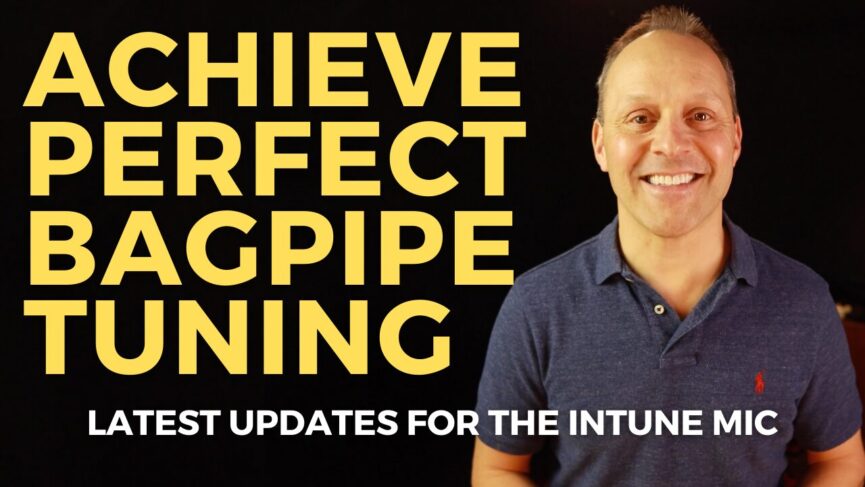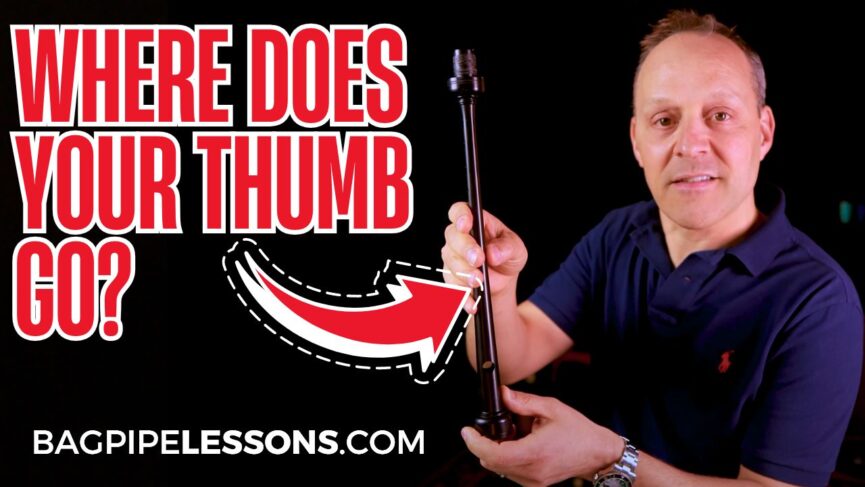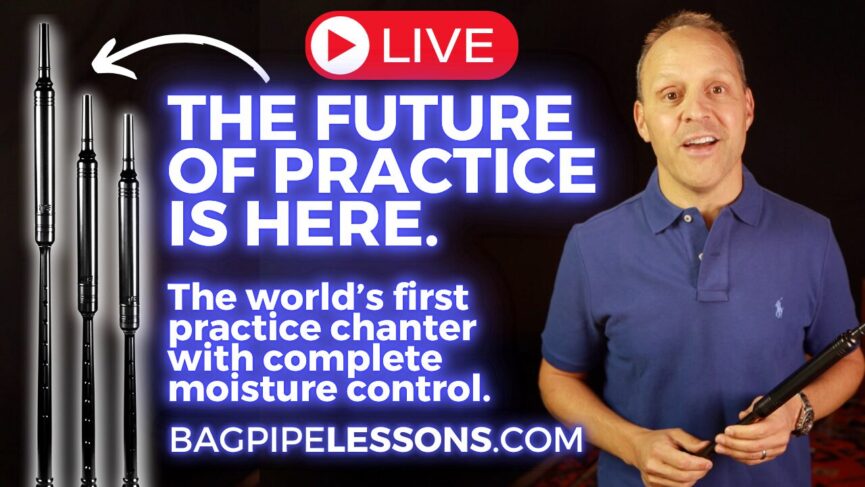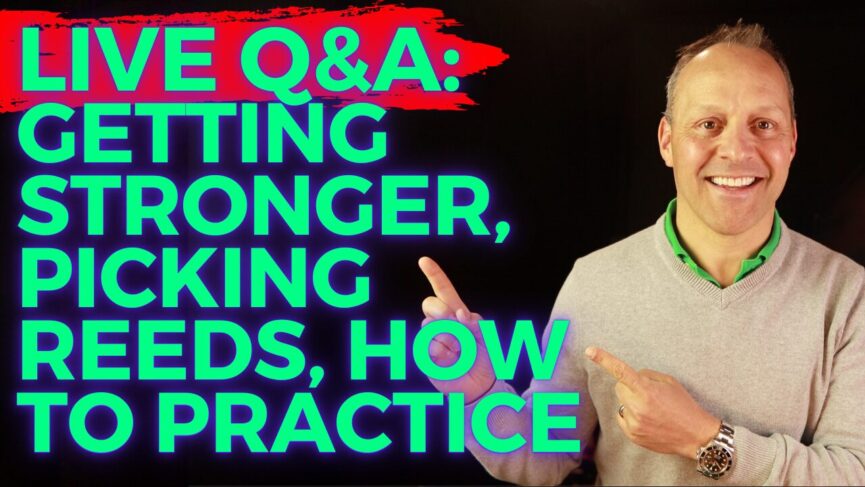
AS FEATURED IN

Secrets for Making Your Pipes Easy to Play
by Jori Chisholm, Founder of BagpipeLessons.com
Last Updated: December 18, 2025
When you watch a top piper, they make playing look so easy. Performing with grace and ease, producing brilliant, rich tone, using sparkling, clear technique incorporating masterful expression — these are all marks of a true professional. Everything always seems to be working in their favor. How do they do it?
Many things need to be learned, practiced, and prepared in order to put forward a top performance. Whether you are a competing solo piper, a pipe band member, or piper who plays for enjoyment alone, an important key to success begins with the proper set up of your instrument. Bagpipes have many components that need to be adjusted, maintained and properly fitted to make sure that they are operating efficiently and are comfortable to play.
Many instruments are still playable if they are in less than top shape. We’ve all seen pianos with missing keys or guitars with broken strings that are still somewhat playable. But a bagpipe with just a small air leak can be difficult or impossible to play.
Some pipers might be under the misapprehension that the pipes are supposed to be physically hard to play — that a good, steady, full pipe sound can only come from pipes that are hard to blow. However, this is not true. We all remember how as beginners, we struggled to develop the strength and stamina in our lips, cheeks, arm, and lungs to keep the pipes going. There is a physical conditioning component to playing the pipes, but once you have built up your endurance and coordination in those key muscles, your pipes should be set up so they sound great and are as easy-to-play as possible. If you feel your pipes are too hard or just don’t feel right, you can find the right solution by first pinpointing the cause of the problem.
There are three primary reasons why bagpipes may feel uncomfortable or inefficient:
- Your pipes are too hard. This is an issue with the chanter reed. The pressure required to keep the chanter reed going is too high.
- Your pipes are taking too much air. This is caused by a leak somewhere (hemped joints, pipe bag, or valve)or by incorrectly adjusted drone reeds which allow too much air to flow through.
- Your pipes don’t fit you properly. This is caused by a pipe bag size and shape that is wrong for your body, or a blowpipe that is too long or too short.
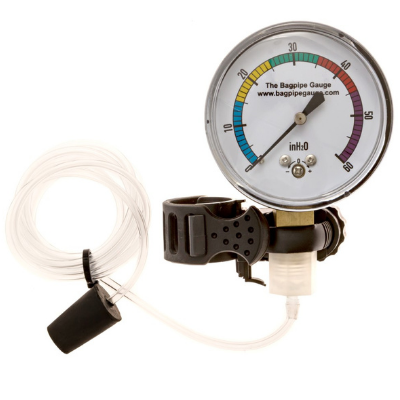
The best way to determine whether your chanter reed is too hard or if your pipes are taking too much air is to use the BagpipeLessons.com Bagpipe Gauge — it is honestly the best tool to learn how to blow with steadiness, and it also gives you an exact measurement of how hard your pipes are. Most pipers play comfortably with a great sound in the range 25-35 on the Bagpipe Gauge. If you use the gauge and find the pressure required to keep your chanter sound going is higher than 35, you should adjust the reed or get a new chanter reed to lower the pressure required.
If your chanter reed pressure is not the problem, your pipes may be taking in too much air. When this is the issue, it usually feels like you can’t keep the bag filled. The air simply escapes from the instrument faster than you can keep up with. This is usually caused by an air leak somewhere or drone reeds that need to be adjusted or replaced.
Steps to Ensure Proper Bagpipe Efficiency
Check that your pipe bag is airtight.
Remove your chanter and drones and put corks in the stocks. Inflate the bag completely full so that you can’t blow in any more air. Squeeze hard on the bag for 15 seconds and check the bag again. Does the bag still feel completely full? If you can blow more air into the bag, you have a leak somewhere. Any leak makes your pipes less steady and harder to play. Try to determine the location of the leak. Look for bubbles, use your ears to listen for a hissing sound, and use your fingers to try and feel the leak. Your blowpipe valve could be leaking. You could be losing air where the bag meets the stocks. The leather or synthetic material could be leaking air. Synthetic bags can be sealed up at the grommets with electrical tape or by tightening up the metal clamps. Leather bags might need to be seasoned or a stock might need to be re-tied. A leaky valve might need to be replaced.
Consider switching to a different type of pipe bag.
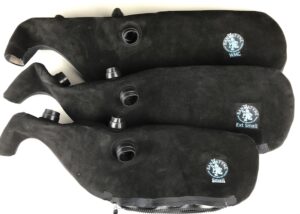 Many pipers play with traditional leather bags (usually sheepskin or cowhide). These bags have served pipers well for generations, but can be troublesome if the leather gets too dry. Hide bags need to be played regularly and require intermittent seasoning to stay airtight. If you are a casual piper or if your career, family or other commitments keep you from playing your pipes regularly, or if you live in a dry climate, consider a synthetic pipe bag that will stay airtight even when completely dry. There are many types of pipe bags on the market today, including bags with zippers that allow access to the inside of the bag, bags with rubber grommets that allow fast and easy installation, and hybrid bags that have a synthetic material on the inside and leather on the outside for a traditional feel. My personal favorite is the Bannatyne hybrid pipe bag.
Many pipers play with traditional leather bags (usually sheepskin or cowhide). These bags have served pipers well for generations, but can be troublesome if the leather gets too dry. Hide bags need to be played regularly and require intermittent seasoning to stay airtight. If you are a casual piper or if your career, family or other commitments keep you from playing your pipes regularly, or if you live in a dry climate, consider a synthetic pipe bag that will stay airtight even when completely dry. There are many types of pipe bags on the market today, including bags with zippers that allow access to the inside of the bag, bags with rubber grommets that allow fast and easy installation, and hybrid bags that have a synthetic material on the inside and leather on the outside for a traditional feel. My personal favorite is the Bannatyne hybrid pipe bag.
Make sure your pipe bag is the right size.
Many pipers struggle unnecessarily simply because their pipe bag is too large. Several years ago, I attended a ceilidh where one of the world’s top pipers played a few tunes and then passed around his pipes. When the pipes were passed to me, I took my turn to play a few tunes. At first, I was surprised at the small size of the pipe bag, but after a few moments it felt incredibly comfortable and easy to keep a steady pressure. Soon after, I switched to a small bag and never looked back. In my experience, many pipers who have switched to a smaller size pipe bag find it quicker to fill the bag and easier to keep it under their arm while playing.
Make sure your pipe bag cover is the right size.
A loose, baggy bag cover can make it harder to keep your pipes under your arm. Many pipe bag covers are one-size-fits-all, which means the covers are too large for medium or small pipe bags. Get a smaller cover, or grab a needle and thread and alter your cover to get a snug fit. Consider some patches of non-slip material to help achieve that feeling of the bag locked under your arm.
Make sure your blowpipe is the right length.
A blowpipe of proper length should allow you to play your pipes with proper ergonomics, keeping your body in a normal, comfortable position. How many times have you seen a piper who has to twist their neck or turn their head away from their pipes just to reach the blowpipe? Or perhaps you’ve seen the piper who has to stretch their hands down to try and reach the chanter? Many sets of pipes come from the maker with blowpipes that are too long, but this can easily be solved with a shorter blowpipe. Many pipe makers manufacture adjustable blowpipes which are perfect for finding the exact length for your needs. The right length of blowpipe will allow you to keep your body in a neutral position, with your head, shoulders, and arms as if you were just standing naturally. Watch yourself playing in the mirror or on video, and consider whether adjusting your blowpipe length might make your pipes more comfortable to play. Borrow a shorter blowpipe from a friend to see if it feels better.
Check your blowpipe for restrictions.
Some blowpipes, especially older ones, have a very narrow inside bore. Try blowing through the blowpipe on its own. Is it free-flowing or is there significant restriction? A narrow bore makes it harder to blow air into your pipes and makes your pipes harder to play. Consider a new blowpipe or take yours to a pipe maker who can drill it out to a wider bore.
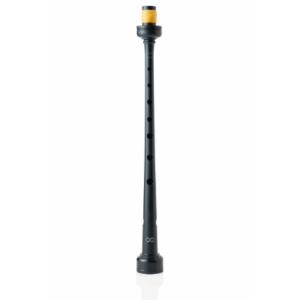 Try an upgraded pipe chanter.
Try an upgraded pipe chanter.
It’s no secret that I love using the Infinity Chanter from R. G. Hardie. It’s been my personal favorite chanter for years now and I consider it a revolutionary design. Why? Its holes are 40% smaller than other chanters and allow for quicker finger movement. That leads to cleaner playing and better overall technique. This is especially useful for pipers with smaller hands or fingers, but is helpful for all pipers to maximize comfort, ease of playing, and increase clarity of execution. I particularly enjoy its warm, bright and efficient sound.
Consider using a mouthpiece protector and a blowpipe positioner.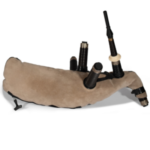
The pipes are one of the few instruments where you actually use your teeth to maintain position. You’ve likely felt tightness in your jaw or soreness in your teeth after playing — I strongly recommend upgrading your ergonomics and comfort with a Perfect Angle™ Blowpipe Positioner, an innovative but straightforward device that allows for blowpipe stability and ideal posture. It keeps your jaw and teeth healthy and happy while maintaining the perfect angle for your pipes. Plus, the Perfect Angle™ comes with a high quality mouthpiece protector for additional comfort — a piece of rubber tubing that fits over the mouthpiece and softens the bite.
Check that the joints are airtight.
Put your chanter and drones back in their stocks. These joints should be the tightest on your pipes, and you should be able to move them only with some real effort. If these joints are loose, add some hemp. Some pipers prefer black waxed hemp, or yellow waxed hemp, or waxed dental floss. Use what you prefer, but keep these joints snug. I avoid using unwaxed hemp as these joints tend to get tight when the hemp gets wet and swells, and loosens as the hemp dries out and shrinks. Always check the joints before you play and add a few wraps of hemp as needed.
Control the moisture content in your reeds.
Fluctuations in humidity and temperature can wreak havoc on sensitive bagpipe reeds. If you find yourself tuning and retuning constantly, or can’t seem to maintain the tone quality you prefer, know that while this is a normal consequence of environmental changes, it is also preventable by using a Tone Protector™. Using two-way humidity control technology, the Tone Protector™ adds or removes moisture as needed to maintain a precisely controlled, specifically chosen humidity level. You’ll find this storage system to not only enhance and maintain better tone and tuning but also to substantially elongate the lifespan of your reeds, saving you time and money.
Check that the tuning slides are snug.
Of your four tuning slides, three are primarily used for tuning. The top slide on the bass drone can be tighter than the others, since it isn’t used as often for tuning. The lower bass tuning slide and the tenor tuning slides should be tight enough that they don’t move on their own, but loose enough that they can be moved by turning with one hand. Some pipers like to use Teflon plumber’s tape here for a nice smooth joint seal. I know a top piper who adds a bit of Vaseline to his slides for a bit of lubrication, but I’ve never liked the idea of putting anything greasy on my pipes. Seat your drone reeds firmly.
Check that the reeds are very firmly in the reed seats.
Really push on the drone reed so it is tight. Some pipe makers thread their reed seats: simply twist the drone reed into the drone and it will stay put. When you insert the drone into the stock, be careful you don’t bump the reed on the stock. You might knock the reed loose causing it to fall into the bag, you might inadvertently bump the reed bridle, or you might even break the tongue of the drone reed.
Optimize your drone reeds for efficiency.
Remove each drone from the stock and mouth blow each one on its own. Each drone should take roughly the same amount of air. The two tenors should be identical and the bass drone should be close, though it might take a bit more air. If you find one is taking more air than the others, try closing down the reed by moving the bridle towards the tip of the reed. Follow your reed maker’s instructions, and remember that small adjustments make a big difference! To make your drones the most efficient, close the reeds down as much as possible, but not so much that they shut off while playing. The exact adjustment will be different for every piper — it depends on the strength of your chanter reed.
Tr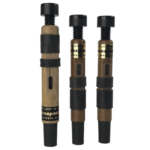 y a new set of drone reeds.
y a new set of drone reeds.
Experiment with different brands of drone reeds and find what works best in your pipes. Ask other pipers who play your brand of pipes. Ask a top piper how they achieve their great sound. Any number of drone reeds on the market should help you achieve a full, rich drone sound that is easy to get in tune, stays in tune, and operates efficiently with minimal effort. My personal favorite is the Ezeedrone Drone Reed Combo Set: Enhanced Design Bass with Increased Absorption & Two Tenor Reeds.
Consider drone valves.
Adjustable drone valves are one of the newest innovations for the pipes. These valves limit the air flow to each drone. They can help you achieve cleaner starts and stops, and they can make your drones take less air. Drone valves might not be for everyone, but depending on your instrument setup, they might be a way to help make your pipes as efficient and steady as possible.
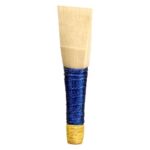 Find the perfect chanter reed.
Find the perfect chanter reed.
By now you’ve checked the bag, the joints, the slides, the drone reed seats, and you’ve also adjusted your drone reeds. The final step is to check the chanter reed. The perfect chanter reed gives maximum sound for minimal effort, warms up quickly, stays in tune for your entire performance or practice session, and lasts a long time. When you hear a top piper or pipe band with a great sound, it didn’t happen overnight.
Many factors contribute to a great chanter sound: selecting a good reed, selecting a good chanter, controlling moisture, keeping a steady bag pressure, manipulating the reed, and more. Some pipers incorrectly believe that a good, bright, stable chanter sound is only possible from a hard chanter reed. In fact, a good, bright, stable chanter sound comes from an efficient reed that has been properly broken in and is blown at the reed’s optimal pressure.
It has never been easier to obtain great chanter reeds. A huge variety of reeds are available for purchase. Ask pipers who you admire to find out what works for them. My personal favorite is the “Foundation” reed.
Try easy or medium reeds instead of hard reeds. Find reeds that are suitable for your comfort level. Instead of playing with a hard reed that you can barely blow, find a medium or easy reed that you can blow firmly and steadily.
You can do it!
Setting up your bagpipes for easy play is not just about making playing less physically demanding; it’s about unlocking the full potential of your music. By carefully selecting and maintaining your equipment, from reeds to bag size, and by adjusting your setup to fit your personal needs, you can achieve a sound that’s not only beautiful but also a joy to produce.
- Make sure your pipe bag is the right size and type for you and that it is completely airtight.
- Verify that your blowpipe is the right length and that the bore is free-flowing.
- Get a well-fitted pipe bag cover that will help comfortably maintain your pipes under your arm.
- Keep your joints airtight and your tuning slides snug.
- Try different types of drone reeds and find what works best for you.
- Seat your drone reeds firmly into the drones and make little adjustments until they sound great and operate as efficiently as possible.
- Find chanter reeds that are within your comfort level.
- Practice enough to make sure you have the strength and stamina to play with steadiness, control, and confidence.
To perform your best, you need to build your strength, stamina, and endurance, but you also need to set up your instrument to be within your comfort level. A top gold medal winning piper told me once that he always competed with a reed that was far easier than what he could physically play. When I give a new pipe chanter reed to one of my students, I remind them that the reed will break in and get a bit easier to play, but also their strength and stamina will grow.
Almost nothing makes your piping better and more fun than a good sounding bagpipe that stays in tune and is comfortable to play. A good performance that is enjoyable for the player and the listener depends on the solid foundation of a properly set up instrument.
With these steps, you can make your pipes easier to play and achieve the sound and piping ease of top performers. I believe in you!

